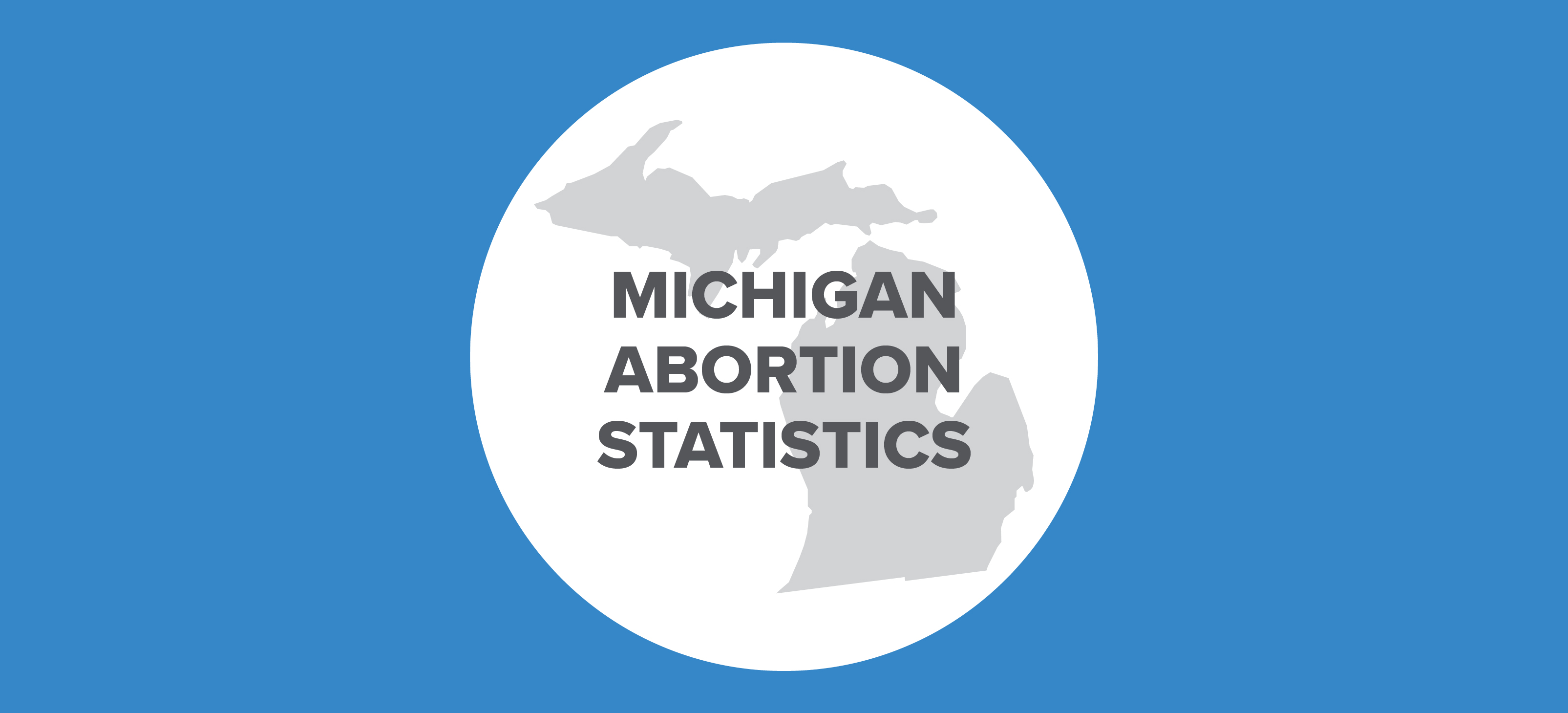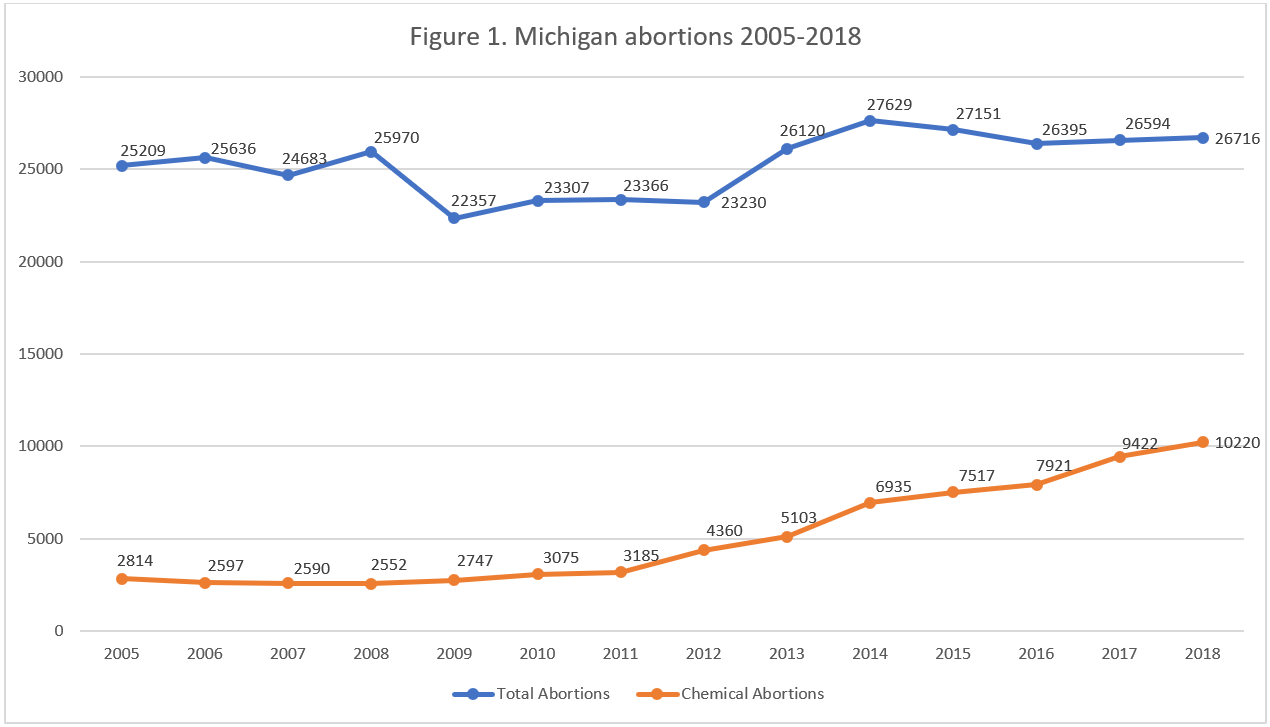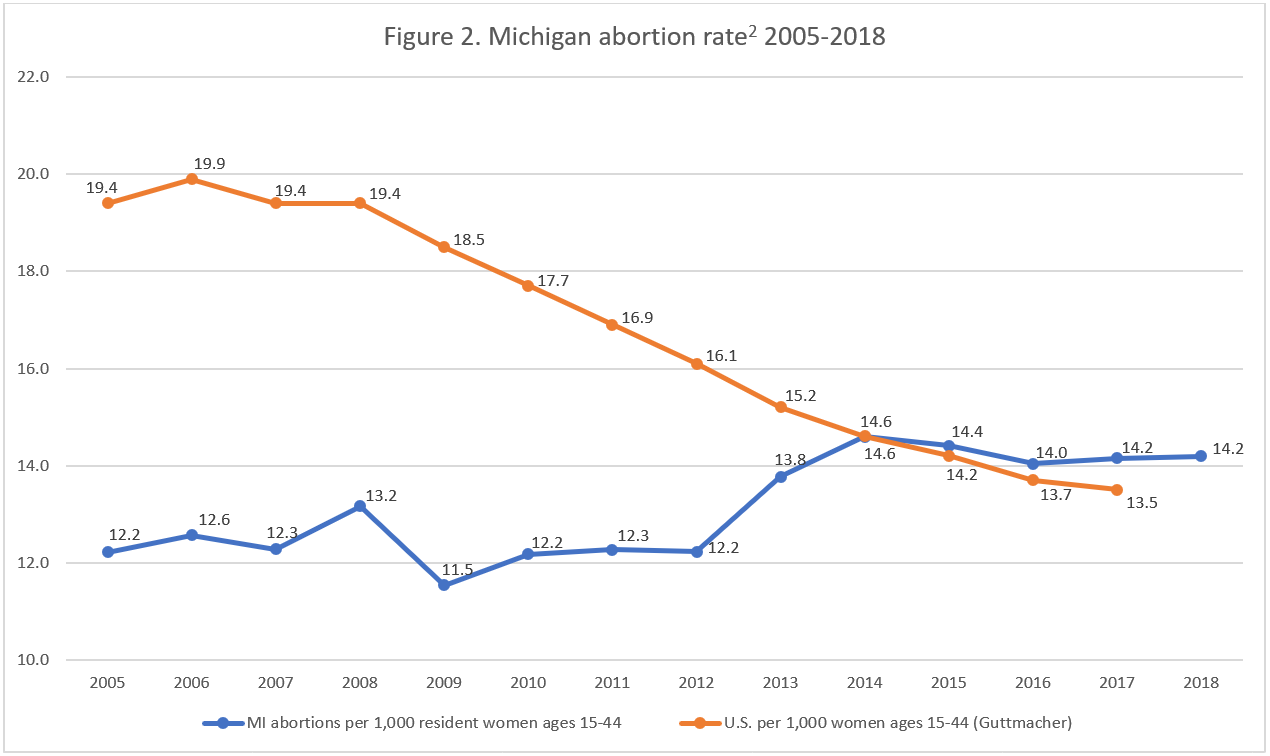Abortion Reporting: Michigan (2018)

Michigan’s 2018 abortion report was published online in June 2019 by the Department of Health and Human Services. The report shows that chemical abortions in the state continue to rise.
Changes in Michigan Abortions, 2017-2018

Information on Planned Parenthood’s Michigan market share is not publicly available.
Abortion Totals and Trends
There was little change in the number of abortions reported in Michigan in 2017 and 2018. Abortions increased by just under half a percent from 26,594 in 2017 to 26,716 in 2018 (Fig. 1). There were 10,220 chemical abortions in 2018, an increase of eight percent from the previous year. In 2018, chemical abortions made up 39 percent of all abortions reported in Michigan. Total abortions in Michigan have fallen by 39 percent since 1982, while chemical abortions have increased by 986 percent from 2001, the first full year after the U.S. Food and Drug Administration (FDA) approved the use of the chemical abortion drug Mifeprex. The Charlotte Lozier Institute estimates that Michigan’s abortion rate was unchanged from 2017 to 2018, remaining steady at 14.2 abortions per 1,000 women ages 15 to 44, near the national average (Fig. 2).
State Report Summary
Residents
Much of the information in Michigan’s annual abortion report is on abortions performed on resident women only. There were 25,554 abortions performed on Michigan residents in 2018, that is, 96 percent of all abortions performed in the state.
Nine percent of the abortions performed on residents were on women under the age of 20. Twenty-nine percent were on women ages 20 to 24, and 32 percent were for women 25 to 29, a change from previous reports in which women in their early twenties made up the largest age group. Twenty-seven percent were in their thirties, and three percent were age 40 or older.
African American women composed the largest racial group, undergoing just over half the abortions performed on Michigan residents. Forty-two percent were performed on white women, even though white women make up 77 percent of Michigan’s population of women of childbearing age and black women compose just 17 percent. Just over two percent of the abortions performed on residents were on Asian or Pacific Islander women, and just under two percent each on multiracial women, women of other, unspecified races, and women whose race was not reported. Not quite half a percent of the resident abortions were performed on American Indian women. Michigan reports ethnicity separately from race, and just under four percent of the abortions were on Hispanic women. The report does not indicate the number performed on non-Hispanic women and women of unknown ethnicity.
Eighty-seven percent of the abortions were performed on unmarried women, 11 percent on married women, and two percent on women of unknown marital status. The vast majority of resident women (just under 95 percent) paid for their abortions out of pocket. Less than five percent were funded by insurance, and not quite one percent were funded by other or unknown methods. Michigan has chosen not to cover elective abortion in insurance plans on its state health insurance exchange, as well as in private insurance and Medicaid plans.
Seven percent of the resident women who got abortions were referred by friends or family members. Two percent received a referral from a physician. Six women received a referral for abortion from a family planning agency, five women from a health department, and four women from a member of the clergy. Three percent received a referral from another source. The majority of women, 88 percent, were self-referred.
Occurrence
While most of the demographic information in Michigan’s annual report is for resident abortions only, some information is provided on all abortion procedures reported in the state. In total, there were 26,716 abortions reported in Michigan in 2018.
Many of the abortions reported in Michigan were performed in the first trimester. Two percent were performed earlier than five weeks of gestation, 63 percent were performed between five and eight weeks, and 23 percent were performed between nine and 12 weeks of gestation. A sizeable number were performed in the second trimester (13 to 28 weeks of gestation). Eight percent were between 13 and 16 weeks and three percent between 17 and 20 weeks of gestation. There were 358 abortions (one percent of the total) performed between 21 and 24 weeks and six abortions performed between 25 and 28 weeks. One abortion was performed in the third trimester after 28 weeks of gestation. Twenty-one abortions were performed at unknown gestational ages.
Over half the abortions in Michigan (55 percent) were suction curettage procedures. Thirty-eight percent were chemical abortions, and seven percent were dilation and evacuation procedures. There were two abortions that were induced with saline or prostaglandins and 39 performed using other or unreported methods.
Pregnancy was confirmed in advance of almost every abortion. Ninety-one percent were confirmed via ultrasound and three percent using a lab urine test. Home urine tests were used before six percent of the abortions. Six pregnancies were confirmed by a lab blood test and three pregnancies were confirmed using other, unspecified means, while the method used was not reported for 27 pregnancies. Six abortions were performed without testing for pregnancy. In 2018, the vast majority of Michigan abortions (91 percent) were performed in freestanding or hospital satellite clinics. Three percent were performed in doctor’s offices, less than half a percent in hospitals, and six percent in other, unspecified facilities.
In 2018, there were eight abortions (one dilation and evacuation and seven suction curettage) that resulted in nine immediate complications.1 These were complications that were identified at the abortion center and reported by the abortion provider using Michigan’s abortion reporting form. One instance of shock, one cervical laceration, and seven cases of hemorrhaging were reported. Six of the abortions that caused immediate complications were performed on women in their twenties and two on women in their thirties. Two of the abortions were performed between five and eight weeks of gestation, four between nine and 12 weeks, one between 13 and 16 weeks, and one at 21 weeks or later.
Sixty-seven abortions were reported to have caused 70 subsequent complications. These were complications identified and treated after the woman had left the abortion center and reported using Michigan’s complication reporting form. In Michigan, physicians are required to report any abortion-related complications they treat. Retained products was the most common complication, occurring in 40 cases. There were 10 hemorrhages, six infections, one case of shock, and one uterine perforation, along with 12 other, unspecified complications. Three percent of the abortions with subsequent complications were performed on women under the age of 20 years, 70 percent on women in their twenties, 25 percent on women in their thirties, and 1.5 percent on women age 40 or older. Forty percent of the abortions were performed between five and eight weeks of gestation and 30 percent between nine and 12 weeks, compared to 4.5 percent earlier than five weeks, another 4.5 percent between 13 and 16 weeks, and 1.5 percent between 17 and 20 weeks. Forty-eight of the abortions (72 percent) were suction curettage procedures. Seventeen were chemical abortions (25 percent), one was a dilation and evacuation abortion, and one was a hysterectomy/hysterotomy abortion. Fifty-six of the abortions were performed at freestanding clinics. Eight were performed at other, unspecified facilities, and one was performed in a hospital.
Seven percent of the unborn babies killed by abortion in Michigan in 2018 weighed between one and 99 grams (3.5 ounces). Three percent weighed between 100 and 399 grams (3.5 to 14 ounces), and over half a percent, 160 babies, weighed 400 grams or more (14 ounces or more). Most of the babies, 90 percent, were not measurable. No cases of babies born alive during abortion were reported in 2018.
Previous Abortions in Michigan
In 2018, 65 percent of the resident women who obtained abortions in Michigan had already carried a pregnancy to term. Twenty-seven percent had one and 38 percent had two or more previous term pregnancies. Twenty-six percent had had one previous abortion, and 23 percent had more than one prior abortion; thus, in total, nearly half of the women undergoing abortions were having a second or subsequent abortion procedure. Twenty-two percent had suffered a prior miscarriage. Michigan’s abortion report notes that the percentage of abortions performed on women with no previous abortions dropped between 1985 and 2018. In 1985, 60 percent of the abortions performed on Michigan residents were on women with no previous abortions. By contrast, in 2018, just 51 percent of the resident abortions were on women who had never had an abortion before.
Over the past three decades, Michigan’s resident abortion rate has fallen by 28 percent, from 18.9 resident abortions per 1,000 Michigan women of reproductive age in 1985 to 13.6 in 2018. However, the first-abortion rate has dropped by an even greater margin. In 1985, there were 24,650 abortions performed on Michigan residents who had never had an abortion before, resulting in a first-abortion rate of 11.3 first abortions per 1,000 women in their reproductive years. In 2018, there were 13,018 first abortions on Michigan residents for a first abortion rate of 6.9, a decline of 39 percent from 1985.
Estimates of a woman’s chances of undergoing an abortion during her lifetime are determined by the first abortion rate. In 2011, the Guttmacher Institute calculated that if 2008 abortion rates held steady, approximately one out of three women would undergo an abortion during her lifetime. In 2017, Guttmacher published an updated estimate using 2014 abortion rates, estimating that not quite one out of four women would obtain an abortion during her lifetime. It is likely that in Michigan, resident women’s chances of undergoing abortions at some point during their reproductive years have fallen over the past few decades.
State Ranking
In the Charlotte Lozier Institute’s 2016 study that evaluated the comprehensiveness and timeliness of abortion reporting across the 50 states and the District of Columbia, Michigan’s reporting tied at 7th best. Michigan reports most of the information it collects but does not make case-level data available to researchers. Michigan also does not report on its informed consent or parental consent processes. Michigan could improve its reporting by including information on informed consent and on all abortions performed in the state, not those performed on residents only.


- Statistics on abortion complications reported here represent a minimal number of deaths and complications, as this data is collected in a non-systematic and non-verifiable way. As such, this data cannot be used to calculate either an accurate abortion mortality rate, nor an accurate abortion complication rate for the state.
- Starting with the 2018 abortion reports, abortion rates are calculated by the Charlotte Lozier Institute to allow for easier state-to-state and year-to-year comparisons. Rates were calculated by CLI using population estimates from the United States Census Bureau. The rates were calculated using the following formula: (total number of abortions performed in Michigan ÷ number of resident women ages 15-44) x 1,000. Rates may differ slightly from previous CLI articles due to revised population estimates.
























